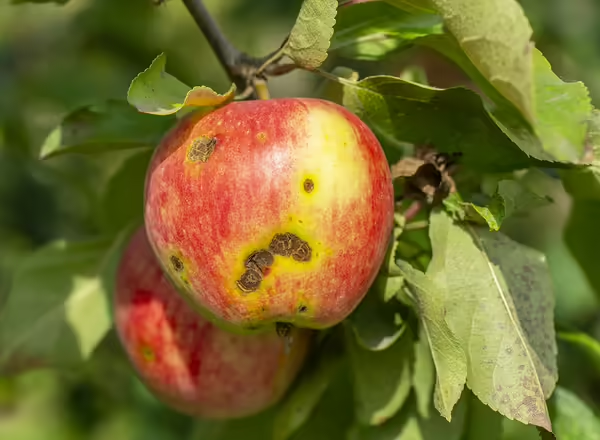
Scab is a widespread and serious disease of apple, crabapple, and to some extent, pear. Scab thrives in cool and humid conditions, like those found in the Midwest during the spring. Dull, smoky spots appear on the young leaves and leaf petioles. The spots soon become velvety and olive green and finally turn black. Scabby leaves curl, wither, and drop early, greatly weakening the tree. Infection of leaves early in the season causes severe defoliation that weakens the tree and results in poor fruit set in the next season. The presence of brownish-black scabby patches on mature fruit results in a malformed and disfigured apple.
Early infection causes fruit to be deformed, knotty, and cracked and often to drop early. This condition lowers fruit grade quality, and therefore, causes the greatest loss. Planting scab-resistant apple cultivars reduces grower costs by eliminating sprays needed for controlling scab. Apple scab and pear scab are caused by different fungi. Apple scab does not infect pears, and pear scab does not infect apples.
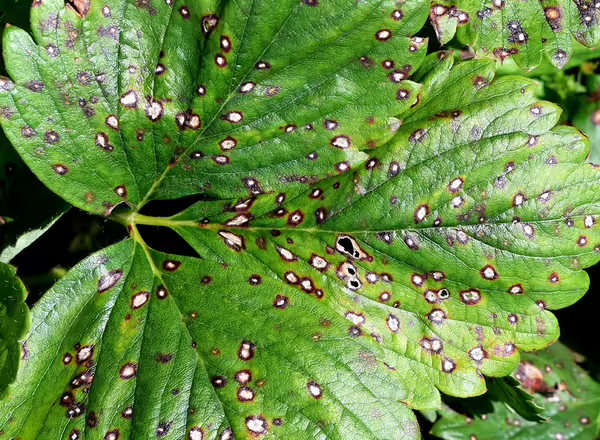
Blotch infects the leaves, twigs, and fruits of apples. Leaf spots are small, round, and light gray with a black dot in the center, or elongated, sunken, and light-colored with several black dots. Severely infected leaves drop early. Rough, swollen, light-colored, perennial cankers may girdle fruit spurs, twigs, and branches. Shiny black blotches that are slightly sunken and irregularly lobed form on the fruits. Several blotches may coalesce to cover a large part of the fruit surface. These fruits may crack.
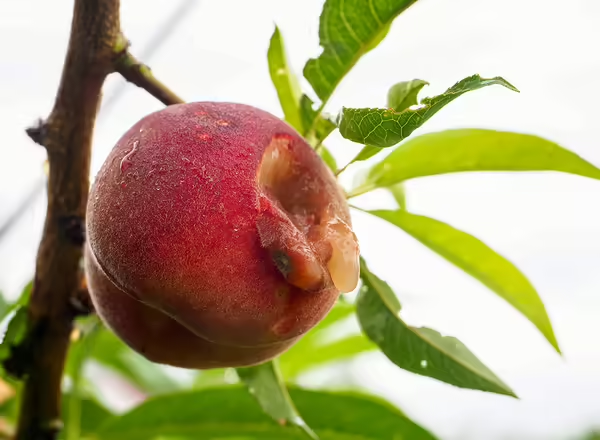
Brown rot is the most common and destructive rot of ripening peach, nectarine, plum, cherry, and apricot fruits. The rapidly enlarging rotted areas are soft and brown. Tufts of brownish gray mold, often in rings, cover the rotted areas. Infected fruits shrivel, gradually turning into hard, wrinkled, black “mummies.” Some may hang in the tree all winter. There may also be browning, wilting, and blighting of the blossoms and new shoot growth. Twigs may wither and die back from sunken, brown, girdling cankers.
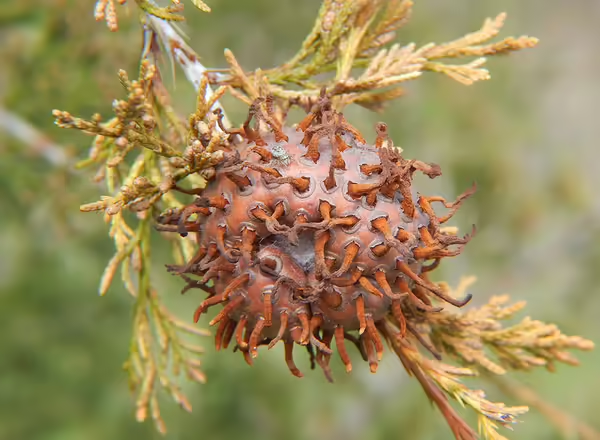
Cedar apple rust is a common destructive disease of apple and crabapple. Small, pale yellow spots form on the upper leaf surface in May or June. The spots soon enlarge, turning orange and black specks (pycnia) later form in the center. A mat of orange yellow “cluster cups” (aecia) appears on the corresponding under leaf surface. Similar rust spots, up to 3⁄4 inch in diameter, may form on the fruits near the calyx end. Early infected fruits may be distorted and drop prematurely.
The closely related quince rust produces dark green, crater-like spots on apple fruits. The flesh beneath these spots becomes brown and spongy. The leaves are not infected.
Upright junipers and red cedars are the alternate host of these rust fungi. Light to reddish-brown galls up to 2 inches in diameter (cedar apple rust) or elongated, rough, dark colored swollen cankers (quince rust) form on the cedar and on some junipers.
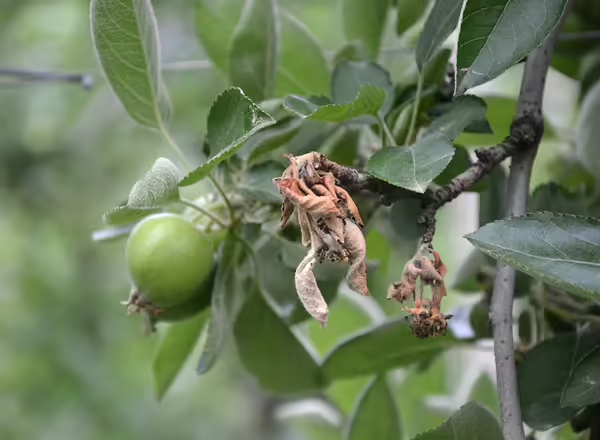
Fireblight is a common and serious disease of apple, crabapple, and pear. Also attacked are many ornamentals including quince, hawthorn, mountain ash, firethorn (Pyracantha), spirea, and serviceberry (Amelanchier). Blossoms and fruit spurs are withered. During June and July new shoot growth suddenly looks as if scorched by fire, with dark brown or blackened leaves clinging to the blighted twigs. The causal bacteria mostly overwinter in slightly sunken, discolored cankers, with a sharp margin, in the branches and trunk. Twigs and branches die back. The disease not only cuts production but may eventually kill the tree. Fireblight is often followed by other diseases including black rot and wood decay. This is an especially serious disease on ‘Bartlett’ pears and on ‘Jonathan,’ ‘Lodi,’ and ‘Paulared’ apples.
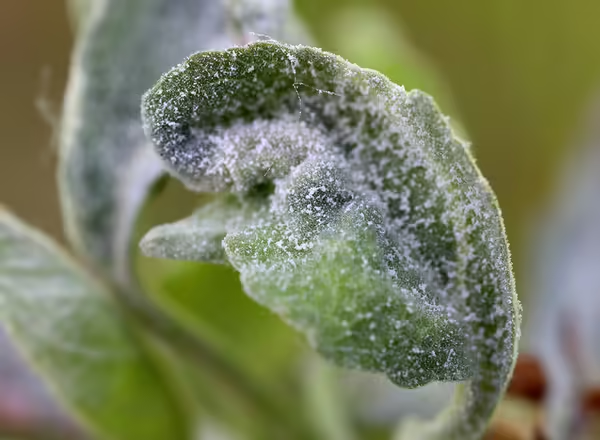
Powdery mildew is becoming a more important disease on apple and crabapple each year in the Midwest. Look for whitish gray, powdery mold or felt-like patches on the buds, young leaves, blossoms, and green twigs. Leaves may be crinkled or cupped upward, dwarfed, narrow and erect. New shoots appear stunted and rosette like, and may die back. Fruits on certain varieties show a brown netlike russeting and may crack.
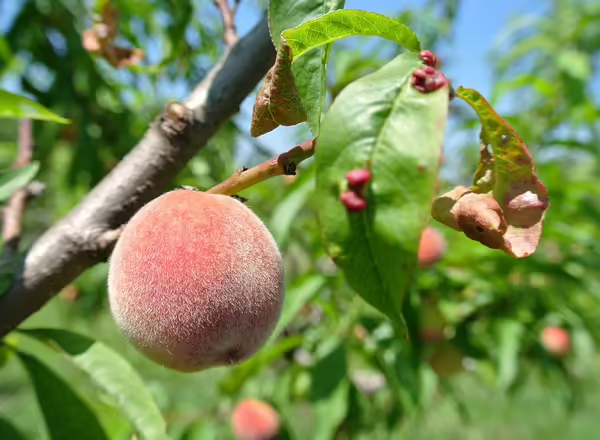
Peach leaf curl is a common and serious disease on unsprayed trees. Unfolding leaves are severely curled, blistered, swollen, and curved upward. The distorted leaves soon turn reddish purple and usually drop in 2 to 3 weeks. A second crop of leaves forms later. Severe attacks weaken peach trees and greatly reduce fruiting.
A closely related fungus causes plum pockets (bladder plum). Infected plum fruits are extremely large, pale, hollow, wrinkled, and drop early.
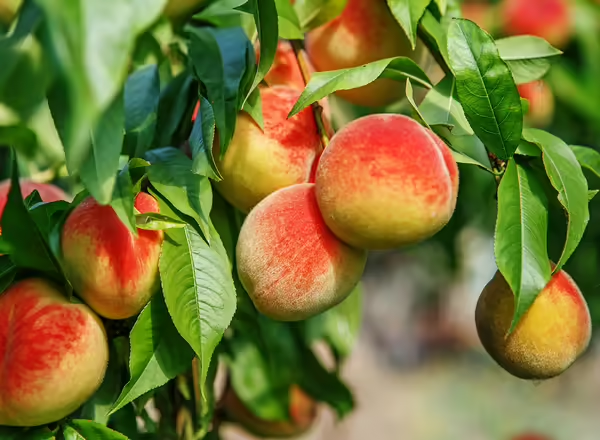
Peach scab causes small, round, dark olive-green to black spots to form on nearly full grown peach fruits. When severe, the spots merge to form irregular, velvety blotches. Fruits may be misshapen and cracked if spots are numerous.
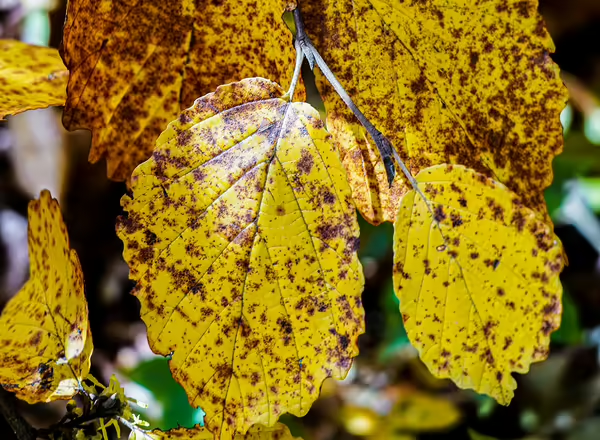
Cherry leaf spot or yellow leaf causes numerous small purple spots to form in the leaves from mid-May to mid-June. The spots enlarge somewhat and by mid- summer the centers of older spots turn brown and fall out. Such leaves appear shot-holed and often turn a golden yellow and drop in large numbers. Fruit on early defoliated trees is often dwarfed, ripens unevenly, and falls prematurely. Severely infected trees are low in vigor, are more susceptible to cold injury and borer attack and may die eventually.
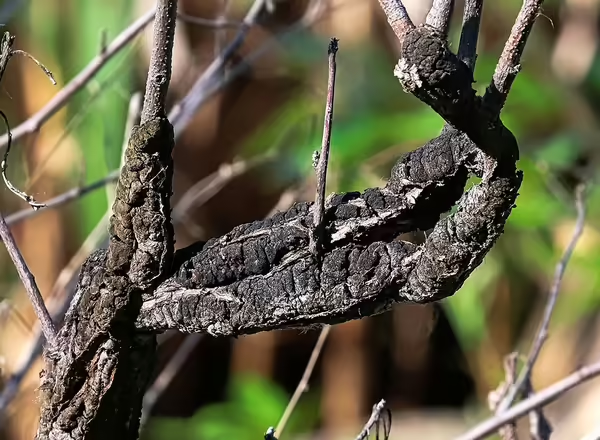
Black knot causes enlarged, rough, blackish growths on the twigs and branches of plum trees. If the disease is not controlled, the growths may become numerous enough to kill the tree.
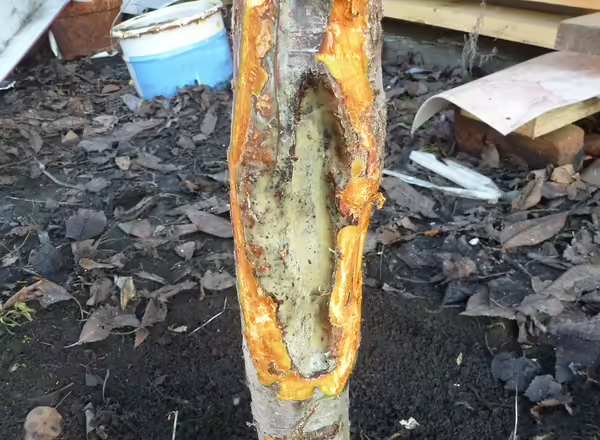
Botryosphaeria rot (Botrot) is most serious on older apple trees. Cankers may form on larger branches, causing them to die. The entire tree may die eventually.
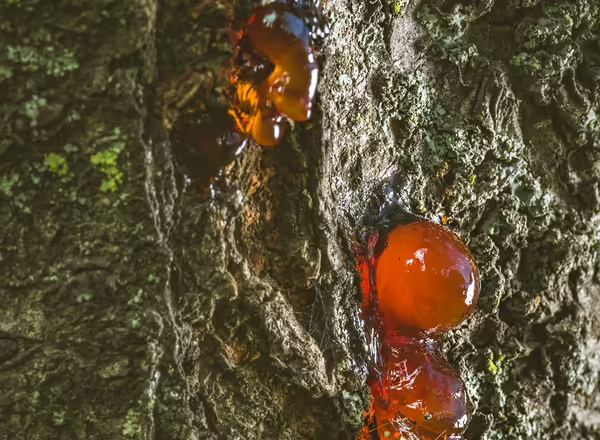
Perennial canker is a serious disease of peach and nectarine trees. The fungus attacks the branches and crotches, causing individual branches or whole trees to die. The symptoms of perennial canker are rough bark areas covered with a black saprophytic fungal growth. The canker fungi invade an area damaged by cold, borers, branch breakage, or other injury. Cankers are favorite places for attacks by lesser peach tree borers.
University of Illinois' history with apple scab
In the early 1900s, an apple fruit breeding program was initiated at the University of Illinois. In 1945, fruit breeders at the University of Illinois and Purdue University used two seedlings from the cross M. floribunda ‘821’ x ‘Rome Beauty’ to begin the present scab resistant apple breeding program.
Through these cooperative efforts, much progress has been made in breeding for scab resistant apple cultivars and thousands of resistant seedlings have since been evaluated for fruit quality, maturity, appearance, yield, and other horticultural characteristics.
Note: All of the apple cultivars presented here are field immune to scab and require no fungicide sprays for this disease; they require reduced sprays for some of the other diseases mentioned. This feature reduces grower costs for both sprays and labor.
‘Prima’, the breeding program’s first cultivar, was released in 1970.The“PRI” prefix is an acronym formed from the three universities: Purdue, Rutgers, and Illinois. The original seedling was planted in Urbana in 1958, and the tree bore first fruit in 1963.‘Prima’ is an attractive, bright red fruit (yellow ground color with 80% red over- color) with excellent dessert quality. It ripens about four weeks before ‘Red Delicious’. The characteristic rich flavor and crisp texture is retained for a month or more when stored at 34° F (1° C). There is little tendency for the fruit to drop before maturity. The tree is spreading and vigorous and has moderate tolerance to fire- blight.
‘Priscilla’, the breeding program’s second cultivar, was released in 1972. Its name was chosen to honor Priscilla Hovde, wife of Frederick Boyd Hovde, the seventh president of Purdue University. The original seedling was planted in Lafayette, Indiana, in 1962, and the tree bore first fruit in 1966. ‘Priscilla’ is a dessert quality apple that is crisp, with a pleasant aroma and flavor. The attractive fruit has a light yellow ground color with a 90% red overcolor. Like ‘Prima’, the fruit does not drop before maturity. It ripens about two weeks after ‘Prima’ or two weeks before ‘Red Delicious’. The tree is moderately spreading and vigorous and has good tolerance to fireblight and moderate tolerance to powdery mildew.
‘Priam’, the third cultivar released from the program (1974), was named for the last king of Troy, the father of Paris. The fruit is too acidic for most American tastes so it has been released for growing in Europe (France, in particular). It is a fall dessert apple with a crisp texture and a pleasant flavor. The attractive fruit has a green yellow ground color with a 90 percent bright red overcolor. The fruit ripens a week or two before ‘Red Delicious’ and can be stored for three months at 35˚F (2˚C).
‘Sir Prize’, the fourth cultivar (1975), is the only yellow golden apple released from the program. Although it has a large attractive fruit, its thin skin and susceptibility to bruising make it unsuitable for commercial orchards, but very desirable for home gardens. It has a juicy flesh with excellent dessert quality. The original seedling was planted in Lafayette, Indiana, in 1955, and the tree bore first fruit in 1961. The tree is vigorous, produces good annual crops, and does not require thinning. ‘Sir Prize’ ripens at the same time as ‘Golden Delicious’. ‘Sir Prize’ is a triploid and, therefore, has a low pollen viability.
‘Jonafree,’ released in 1979, is the program’s fifth scab resistant apple cultivar. The original seedling was planted in Urbana in 1965, and the tree bore first fruit in 1972 .‘Jonafree’ ripens at the same time as ‘Jonathan’ and is very similar to it in appearance and flavor. The attractive, glossy red fruit (95% red overcolor) has a crisp, juicy flesh. The tree is much less susceptible to fireblight and powdery mildew than is ‘Jonathan.’
‘Redfree,’ released in 1981, is the program’s sixth cultivar. This apple has an attractive red color and a crisp, juicy flesh. It is a high-quality summer apple with a firm flesh and it does not drop easily from the tree. It retains its quality and firmness up to two weeks after maturity. When stored at 34˚F (1˚C), this apple can retain its quality up to two months. The original seedling was planted in 1966, and the tree bore first fruit in 1971.‘Redfree’ matures two to three weeks before ‘Prima’ and six to seven weeks before ‘Red Delicious’. This apple seems to have broad climatic adaptation. The tree does not require fruit thinning. It has a semi upright growth habit and sets good annual crops. The tree has moderate tolerance to fireblight and powdery mildew.
‘MacShay’ was released in 1981, in cooperation with Oregon State University. This scab resistant apple was released for Oregon growing conditions. This is a high quality, red apple (80 % overcolor) with a juicy, fine-grained flesh. The fruit retains its quality and texture for two months or more when stored at 34˚F (1˚C). It ripens two weeks before ‘Jonathan’. The tree is upright and vigorous and has good tolerance to powdery mildew.
'Dayton' was released in 1988. Fruits need to be thinned. It produce large fruits that are glossy red and ripens four weeks before 'Red Delicious.' The fruits may store for about one month. ‘Dayton’ has good resistance to powdery mildew and cedar apple rust. The tree is vigorous with strong upright branches.
'Enterprise' is a later maturing cultivar that was released in 1993 by Purdue, Rutgers, and Illinois. It has tart fruit, with red skin and yellow flesh. The fruit retains quality and texture for over 6 months in storage. The tree has a vigorous growth habit, and it is prone to corking.
'Gold Rush' was released in 1994 by the PRI program. The fruit ripens late, medium to large in size, spicy to slightly acid taste, and can store for about seven months. The tree has an upright growth habit and tends to have a moderate vigor.
'Liberty' is a mid-season apple that matures at the same time as 'Empire' and about 10 days after McIntosh. The fruit tends to be small, dark red in color, and may require several pickings. The fruit flavor is much better after storage. Fruit can be stored up to three months. It is resistant rusts, powdery mildew, and fireblight. It has been reported that Japanese beetles tend to like it better than other cultivars.
'WineCrisp' is one of the recent releases from the University of Illinois breeding program in 2009. It has a dark red fruit that is firm. The flavor is between too sweet and too tart. The cultivar ripens in mid-October.